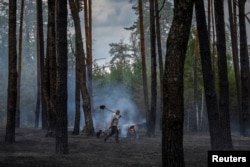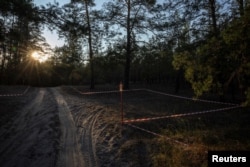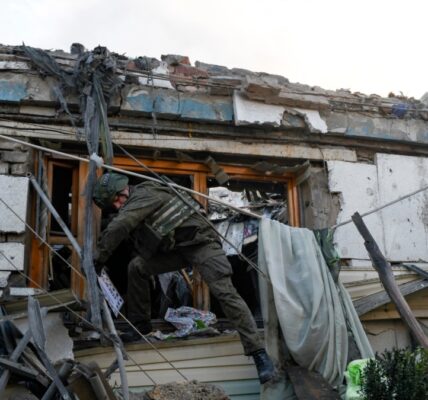Sviati Hory National Nature Park, Ukraine —
Serhiy Tsapok surveyed the smoldering ruins of pine trees, blackened stumps as far as the eye could see.
“They’re dead now,” the weary ranger said of the trees he’d nursed for almost two decades. The 41-year-old’s daily route through the Ukrainian forests, once a joy, has become a nightmare.
The fire he fought, caused by a blast of undetermined cause, wiped out three hectares of 80-year-old pine trees at the Sviati Hory National Nature Park in eastern Ukraine, according to officials there. Four-fifths of the park’s nearly 12,000 hectares have been damaged or destroyed by fires or ordnance, they said.
It’s a tiny portion of the damage caused by the war, which has brutalized the landscape of Ukraine and much of its 10 million hectares of forests. Both Russian and Ukrainian armies blast thousands of shells at each other every day, shredding the earth in grinding combat that echoes the trench warfare of World War I.
Reuters spoke to nearly 20 specialists in the field, including forest rangers, ecologists, demining experts and government officials, who provided a detailed picture of the ruin wrought on Ukraine’s forests by the 31-month-old war.
Russian authorities didn’t respond to requests for comment for this article.
‘Enormous’ loss
The director of the Sviati Hory park, Serhiy Pryimachuk, told Reuters that Russian munitions had burned vast tracts of the area, once a rare and beloved beauty spot in a heavily industrialized region.
“What we have lost is enormous,” he said.
Tending to forests is now a perilous occupation, with mines and unexploded shells hidden in the ground posing the biggest threat.
Ranger Oleksandr Polovynko, 39, nearly lost a foot after stepping on a mine while tending the forest last year. “I crawled back to the car and drove home with one leg,” he recalled. It took him six months to return to work.
All that remains of many forests in eastern Ukraine are fields of stripped, broken trunks. Local wildlife, including deer, boars and woodpeckers, have been badly affected by the loss of habitats, the experts said.
In northern Ukraine’s Chernobyl nature reserve, the pre-war population of over 100 Przewalski’s horses – a globally endangered species of wild horse – has been hit hard by the conflict, according to Oleh Lystopad, an ecologist with the ANTS advocacy group who said landmines were making it difficult to extinguish fires.
“Right now, it’s in question to what extent this species can continue to exist there,” Lystopad said.
Bleak legacy
The damage to forests is part of a broader trail of environmental destruction caused by the war, which could leave a bleak natural legacy for decades to come, having poisoned the soil and rivers, polluted the air and left vast tracts of the country riddled with mines, according to the experts.
The dense pine forests common to eastern Ukraine catch alight easily and have been decimated by the conflict, said Brian Milakovsky, a U.S.-based forester who until recently lived and worked in Ukraine for eight years.
The war has torn through the habitats of some unique flora such as the chalk pine, a rare subspecies of Scots pine, according to ecologists and park officials.
Milakovsky said the environmental crisis was particularly acute in Russian-held areas – nearly a fifth of Ukraine – where occupation authorities appeared to have little capacity to extinguish forest fires. He estimated about 80% of the pine forests in the eastern region of Luhansk had been destroyed.
About 425,000 hectares of forest across the country have been contaminated by mines and unexploded ordnance, according to the environment ministry.
Authorities say they still need to inspect up to 3 million hectares of forest that are or have been occupied by Russian forces and are likely riddled with mines and ordnance. The foresters interviewed said the Russians were heavily dug in and left booby traps and tripwires behind as they retreated.
“If we want to extinguish a fire quickly, it’s impossible because the entire territory is mined,” Ruslan Strilets, who was Ukraine’s environment minister when he was interviewed in July. “There is a risk of being killed or maimed.”
Indeed, on top of serious injuries to rangers like Polovynko, 14 forest workers have been killed by landmines, booby traps or shelling during the conflict, according to environment ministry data.
Decades of work, billions of dollars
The specialists interviewed said repairing the damage to the forests would take decades and cost billions of dollars. Some doubted whether some heavily mined areas of forest would ever be cleared, citing past examples of forests declared no-go zones after previous European wars.
The official estimate is that demining all contaminated territory, including forests and other areas such as agricultural land, will take 70 years, Strilets, who has since been replaced as environment minister, told Reuters in Kyiv on July 22.
Four ecologists with expertise in Ukrainian forests said the subsequent process of regenerating damaged areas would be complex and could take decades, plus billions of dollars of investment.
According to a June 2024 study on the Ukraine war’s carbon emissions, conflict-related forest fires directly emitted greenhouse gases equivalent to 6.75 million metric tons of carbon dioxide, the equivalent of the annual emissions of Armenia. Ukraine has also lost the carbon capture potential of those burned trees.
The World Bank estimated in February that the damage wrought by the war on forests and other protected natural areas, including marshes and wetlands, exceeded $30 billion.
Source: voanews.com





